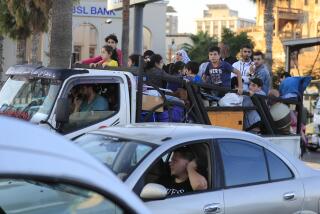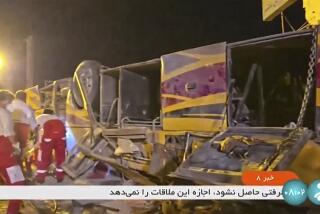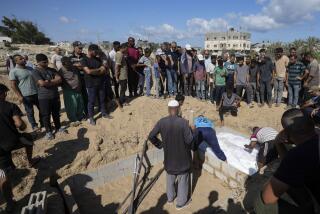At Least 845 Pilgrims Die in Stampede in Baghdad
BAGHDAD — Hundreds of Shiite Muslim pilgrims participating in an annual religious commemoration in northern Baghdad were killed Wednesday in a stampede on a bridge apparently triggered by fears of an insurgent attack and exacerbated by tight security restrictions.
At least 845 pilgrims, most of them women, children and the elderly, died. The Ministry of Health said the toll could rise to 1,000 or more. It was the highest death toll in any single incident in Iraq since well before the 2003 U.S.-led invasion and was more than four times higher than that of the largest insurgent suicide bombing.
At least 400 Iraqis were injured in the chaos as they tried to cross a four-lane, quarter-mile bridge that spans the Tigris River. The victims were among the million Shiites from Iraq, Iran and elsewhere who had crammed into Baghdad’s Kadhimiya suburb to commemorate the martyrdom of Imam Musa al Kadhim, an 8th century Shiite saint, at his shrine.
“I died over and over again,” said Iraqi Army Col. Hassan Jabouri, who carried away many dead children. “It’s very hard to see a baby die in front of you.”
Many of the victims were from Sadr City, the eastern Baghdad neighborhood where 2 million mostly poor Shiite Arabs live. As dusk settled, the streets of Sadr City turned into a vast funeral procession, as weeping men set up mourning tents and bodies were laid out in mosques to be washed before burial.
One woman arrived at the Saheb Zaman mosque in a taxi, crying and beating her face. She said she had lost her 9-month-old child in the crush and had come to search for him among the corpses.
“One family lost four members,” said Fatah Sheik, a Sadr City politician who estimated that 600 of the dead were from his neighborhood. “We found a lady from Sadr City dead with her dead child lying on her chest. An old man took his two grandsons to the shrine. They came back in three boxes.”
The exact cause of the melee remained unclear. Several mortar rounds, apparently fired by insurgents, had fallen on the crowds earlier in the day, killing at least six and making pilgrims and the many Iraqi soldiers and police officers on the scene skittish.
Pilgrimages at shrines in Baghdad and the southern cities of Najaf and Karbala have been marred by suicide bombings -- at least 181 people were killed in coordinated blasts at Shiite shrines in Karbala and Baghdad in March 2004, the deadliest such incident.
Some witnesses Wednesday said pilgrims panicked after a rumor spread that a suicide bomber was among them. The crowd was boxed in between high metal fences along the concrete-and-steel-girder bridge and unable to move backward or forward because of checkpoints in front and oncoming pilgrims behind.
Others said additional mortar rounds had been fired at the pilgrims, causing the panic.
Some victims, desperate to avoid being trampled, jumped into the river’s muddy currents and drowned, witnesses and officials said. Most suffocated or were trampled to death as they tried to escape the two-hour morning melee.
Survivors described macabre scenes of chaos. Ali Younis Hossein, a 32-year-old laborer sitting on a mattress in the hallway of Karkh Hospital, described being nearly choked to death by the crowd on the Aima Bridge and pointed to a bite mark on his ankle inflicted by a victim underfoot.
“I had to step on them to get away,” he said.
Survivors and security officials struggled to evacuate the injured and dead, their faces and lips blue from suffocation. Baghdad’s hospitals were overwhelmed with the grieving and the dead.
After the chaos subsided, survivors gasped as they walked past mounds of colorful plastic slippers that were lying on the bridge along with tangled black abayas and purses.
Weeping women sorted through the piles, looking for the slippers of loved ones while scavengers searched the piles for valuables.
“My relatives are missing,” said Saadeh Obeid, a 50-year-old woman.
In the midst of the macabre scene, one man repeatedly cried the Islamic monotheistic creed, “There is no god but God.”
Iraqi politicians, including transitional Deputy Prime Minister Ahmed Chalabi and National Security Advisor Mowaffak Rubaie, toured the scene, flanked by large security details.
Iraqi officials acknowledged that the tragedy probably was compounded by security measures taken to prevent insurgents from crossing into the Kadhimiya neighborhood during the Shiite observance.
Kadhimiya is a mostly Shiite neighborhood, whereas the area across the river, Adhamiya, is mostly Sunni Arab, the minority sect that once dominated Iraq and has driven the 2 1/2-year insurgency against U.S.-led forces and the Iraqi government.
Officials had worried that a recent uptick in sectarian violence could lead to full-fledged fighting between Sunnis and Shiites, especially as pilgrims marched through the streets of Adhamiya during the Imam Kadhim commemoration. Instead, Sunnis were seen helping evacuate injured Shiite pilgrims.
Saif Nazar, a 23-year-old Sunni who drove victims to Numan Hospital, said, “Some of them jumped into the river, even if they didn’t know how to swim, just to escape the situation, so they drowned. Most of the people I rescued were women.”
Gen. Rawad Rumediam, a military commander at the bridge, said that 3-foot-high concrete barriers put in place to prevent car bombers from entering probably contributed to the crush. Saadoun Dulaimi, Iraq’s defense minister, said the checkpoints, where pedestrians were searched for explosive devices, may have slowed the flow of pilgrims across the bridge and contributed to the disaster.
“Crowds gathered and a scream caused chaos in the crowd, and the crowds just reacted and this sorrowful incident took place,” he said at a news conference.
Brig. Gen. Abdul-Jalil Khalaf, military commander of Kadhimiya, said in a television interview that the bridge “was not suitable for the use of pedestrians.”
Survivors, some wandering upon the bridge after the stampede, blamed security officials for the deaths. Many criticized the government of Prime Minister Ibrahim Jafari.
“We asked the army troops to lift the concrete barriers from the road but they told us that the Americans put them in and they can’t move them,” said Jasim Kinani, who was among the many black-shirted young male volunteers helping with crowd control around the shrine.
Many feared that bodies were still in the river. Health Minister Abdul Mottalib Ali said the government had been seeking to guard against possible violence, but added, “We never prepared for such a big number” of casualties.
The disaster is among the deadliest in recent Iraqi history. In the Middle East, stampedes in Mecca also have killed hundreds in recent years. In 1990, more than 1,400 Muslim pilgrims died during the annual hajj in Saudi Arabia.
Iraq’s transitional government moved swiftly to limit potential political fallout, blaming “terrorists” for launching the mortar attacks before the stampede and suggesting that insurgents intentionally incited panic by spreading false rumors about an impending attack.
“We ask the people to be patient and vigilant and to continue our march for all of Iraq,” Prime Minister Jafari said, declaring three days of national mourning.
“This tragedy will be a new reason to keep Iraq unified,” he said.
U.S. Ambassador Zalmay Khalilzad said that Washington was “prepared to offer whatever assistance we can to help the victims of this terrible tragedy.”
The deaths come at a particularly sensitive time for Iraq’s ruling coalition of Shiites and Kurds, who, with Sunni Arabs and other groups, have been writing a new constitution that is to be put to voters in an Oct. 15 referendum. The draft faces opposition from many Sunni Arab leaders.
There also is growing frustration among Iraqis of all backgrounds about the government’s inability to control violence and restore public services, such as electricity.
Opposition politicians lambasted the government for failing to provide adequate security and called for the resignations of Iraq’s defense and interior ministers.
“This is going to weaken support for the government even more,” predicted Saleh Mutlak, a top Sunni leader.
Despite the high death toll, most said the government would survive the crisis because Iraqis have grown accustomed to daily bloodshed.
“You have to realize how fatalistic the people have become,” said Sharif Ali Hussein, leader of a monarchist political party. “The effect is cumulative. It’s another crisis in the daily lives of Iraqis that will add to the malaise happening in the country.”
Indeed, the day’s irony was not lost on Shiites. After years of imprisonment and torture by a Sunni caliph, Imam Kadhim was poisoned and his body dumped on a bridge in the same area more than 1,000 years ago. Shiites consider it an obligation to cross the Aima Bridge before paying homage to Kadhim at the shrine.
“We are cursed,” said one burly man on the bridge. “We are marked with mud.”
Times staff writers Ashraf Khalil, Raheem Salman, Saif Rasheed and Shamil Aziz and a special correspondent in Baghdad contributed to this report.
More to Read
Sign up for Essential California
The most important California stories and recommendations in your inbox every morning.
You may occasionally receive promotional content from the Los Angeles Times.










